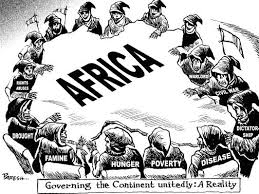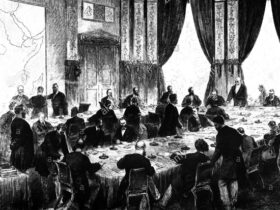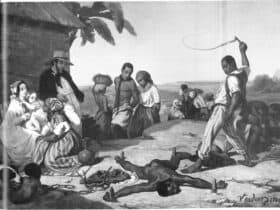History form 3: The establishment of colonialism and African reaction
Colonialism is the situation where by one country dominates or rule another country socially, politically, economically and culturally. Most African countries were colonized by European countries after the Berlin conference except Ethiopia and Liberia. African countries lost their independence, sovereignty and control over their own matters after being colonized. History form 3: The establishment of colonialism and African reaction
Therefore during the imposition of colonial rule it was not easy for colonialists to penetrate into the interior of Africa because;
1. Africans were not ready to be colonized.
2. Africans had their own systems of governance.
3. Africans had their own system of social, political, economic and culture.
4. Africans had a strong leadership and army which strongly protected their state etc.
THE METHODS / WAYS OF ESTABLISHING COLONIAL RULE
There are various ways or methods/tactics employed/ used by colonialist to impose / establish colonial rule in Africa are as follows;
1. Diplomacy method [signing of treaties]
2. The use of force [military conquest] violence.
3. Alliance or collaboration
4. Administrative technique e.g Direct rule, indirect rule and Assimilation.
5. Ideological methods e.g Introduction of Western Education, Western civilization racism and introduction of Christianity.
6. The use of infrastructures and communication Media.
7. Economic technique e.g Destruction of Industries, this was done by importing ready manufactured goods from abroad e.g clothes, beards, wine.
The techniques / tactics / methods or ways mentioned above were applied or used in imposing/establishing colonialism because the colonialists find some difficulties since Africans were not ready to be colonized therefore they applied these tactics as follows;
1.The Diplomacy Method [the signing of treaties]
This method was the method of signing bogus treaties done by colonialist with African local rulers which cheated Africans to accept colonial control. African local leaders signed those treaties without understanding their meaning because they did not know how to read and write. After signing the treaties African local leaders would find their areas colonized. For example; Karl Peters signed many treaties with chief Mangungo of Msovero, Kilosa, Usangara and Uluguru. Stanley signed treaties with king Lobengula of Ndebele [Zimbabwe].
2. Military Conquest / Use of Force
Military conquest was a method/way of imposing /establishing colonial rule where by colonialist used military force such as army, soldiers, police etc to force Africans to accept colonial rule when the diplomacy method/way failed. For example Germany used force /violence/ military conquest to force Mkwawa of the Hehe to accept colonial control in his territory.
1. ACTIVE RESISTANCE
It is the form of resistance where by Africans took arms to fight against colonial rule, or active resistance is the one which Africans wage war to oppose colonial rule by destructing European properties like farms, killing Europeans and so on. Examples of African societies which applied active resistance against colonial systems were: Nyamwezi, under Isike, Hehe under Mkwawa and Yao under Machemba.
Why some Societies of Africa Succeeded / were able to apply active resistance?
1. Presence of strong/ good leadership e.g. Samori Toure and Mkwawa.
2. Strong army.
3. Strong unity among the people.
4. Good war techniques.
5. Strong organizations /political systems.
6. Powerful socially and economically
2. PASSIVE RESISTANCE
It is the form of resistance where by Africans did not take arms in opposing colonial rule or cooperating with colonialists. Or, Passive resistance is unarmed or nonviolence opposition against colonial control by refusing to pay taxes, production of cash crops, denied to work etc. an example of a society which applied passive resistance was Pogoro who refused to involve in colonial activities like cotton picking in southern Tanganyika.
Why some African Societies Applied Passive Resistance not Active Resistance?
1. Poor weapons
2. Absence of strong army; presence of weak army made some African societies to afraid to fight.
3. Weak leadership
4. Poor unity among the people.
5. Presence of natural calamities for example floods, droughts.
6. Weak social and political organizations.
Reasons Why African Societies Fought against Imposition of Colonial Rule
1. To defend social and political sovereignty. Many societies in Africa decided to resist colonial rule because colonialist wanted to interfere their social and political power. So African chiefs or leaders such as Mkwawa, Samora Toure and Kaberege etc took army to fight against it.
2. Interference of trade. Africans resisted against imposition of colonial rule because colonialists interfered with African trade monopolies which made Africans harsh towards colonialists hence resistance.
3. Interference of cultures. African resisted against imposition of colonial rule since colonialists wanted to interfere African culture such as religion, language etc.
4. Land alienation. Africans resisted against imposition of colonial rule because colonialists took African’s land as a result Africans took arms to fight against this.
5. Forced labour. Many African societies imposed to resist once against colonial rule since colonialists forced them to work by force without payment in colonial activities like farms, construction of BOMAS etc. Examples of resistances were Majimaji, Nandi resistance, Chimulenga etc.
6. Introduction of taxation. Colonialists introduced different heavy taxes such as head tax, cattle tax, hut taxand matiti tax where Africans were forced to pay them as a result they resisted against the imposition of colonial rule.
7. Harsh rule. The colonialists were very brutal and harsh in rulling the Africans, many Africans were oppressed and killed.
8. Africans were not ready to be colonized. Africans resisted against the imposition of colonial rule because they were not ready to be colonized since they had their own system of governance and administration.
9. Beliefs of political and military strengths. African societies were believed that they were powerful and strong in political and military as a result when colonialist came they opposed against them for example chief Machemba of Yao disobeyed Germany governor WISSMAN because he believed in his military power.
10. Colonial social segregation and discrimination. Africans resisted against colonialist because Africans were segregated, oppressed and discriminated by them and treated as inferior in social, political and economic issues as a result Africans resisted them harshly
11. Alliance / collaboration between traditional enemies with the colonialists.
TYPES OF RESISTANCE
There are two main types of resistance namely:
I. Small scale resistance [ primary resistance]
II. Large scale resistance[secondary resistance]
I. SMALL SCALE RESISTANCE
Small scale resistance is the type of resistance which fought for a short period of time over a small area or small group of people. Small scale resistance normally covered a small area fought on the basis of tribal lines occurred during penetration of colonialists i.e. the Nandi, Hehe, Nyamwezi etc. Small scale resistance was influenced by local rulers [leaders] who organized their small groups of people to take army against European invaders to defend their territories.
Examples of Small Scale Resistance which will be discussed are
1. The HEHE resistance [1891-1898]
2. The NYAMWEZI resistance [1891-1894]
3. The YAO resistance [1888]
4. The BUNYORO resistance[1893]
5. The MASAI [Kenya resistance 1895]
6. The NANDI resistance
1.THE HEHE RESISTANCE [1891-1898]
Hehe resistance was a small scale resistance which occurred in 1891-1898 fought against Germany under the leadership of Mkwawa. Or, Hehe resistance was a small scale resistance fought between the HEHE tribe against Germany in 1891-1898 under the leadership of MKWAWA.
HEHE resistance was among of the strong and powerful resistance imposed towards Germany colonial power since it fought for many years and brought a lot of damages, sufferings and disturbances to Germany because HEHE tribe under the leadership of MKWAWA had good war techniques inherited from the Ngoni tribe such as cow horns, short stubbing spears and long hide. Therefore through good war techniques HEHE under MKWAWA formed a strongest kingdom and resisted against Germany rule than the rest resistance in East Africa.
Causes or Reasons of Hehe Resistance
1. Interference of Mkwawa’s leadership, Germany wanted to control Mkwawa and forced him to accept Germany control due to that Mkwawa disagreed to accept Germany rule.
2. To protect political and economical interests.
3. Interference of culture; Germany interfered Hehe culture such as polygamy belief in many systems etc which made the Hehe under the Mkwawa harsh hence fight against Germany.
4. Germany harsh rule; Germany ruled Hehe very harsh not respectful to the Hehe, they forced them to pay tax, to work and took their land as a result the Hehe fought against the Germany.
5. Killing of the Mkwawa’s delegates. Germany killed Mkwawa’s delegates who were sent to compromise as a result Mkwawa revenged by killing Germany commander known as EMIL VON ZELEWSKY and 300 African soldiers as a result war started. The name Mkwawa means conqueror of lands.
6. Germany’s occupation / control several areas in Tanganyika. Hehe under Mkwawa fought against the Germans because they wanted to control Ugogo, Uluguru, Usagaraand Mpwapwa which had 410 economic importances to the HEHE.
7. Blocking trade routes; Hehe resistance against Germany occurred following Mkwawa blocking all Germany caravan routes passed his area which disrupted the Germany trade hence conflicts started.
Due to the above reasons or causes of the Hehe resistance the war/fighting broke out which took a long period of time. The Germany attacked Mkwawa in 1891 following the killing of the Germany commander Emil von Zelewsky at Lugalo. In 1894 Germany attacked Mkwawa’s capital known as Kalenga but Mkwawa succeeded to run away [escape] and started to fight the GORRILAS WARFARE until 1898. In the same year 1898 Mkwawa while he was hiding himself he became sick. The Germans approached where he was hiding Mkwawa did not accept the shame of surrender to Germany while he was alive he shot himself in July 1898 and died.
2. THE NANDI RESISTANCE [1896-1905]
Nandi resistance was a small scale resistance fought between the Nandi tribe in Kenya against British in 1896-1905 following the British occupation or control over the Nandi’s land. Or, Nandi resistance was a small scale resistance occurred in 1896-1905 when Nandi tribe in Kenya resisted against the British control over their land organized by a leader known as KOITALEL and ORKOLYOT.
The Nandi resistance occurred since the British invaded and occupied [control] the Nandi land by constructing [build] telegraphic lines and railways along the Nandi rift valley land which were fertile for crop production and livestock keeping. The Nandi were not happy for the construction of that railway lines and termed or called ”Iron snake”. Therefore they started the resistance by attacking the British military position, uprooting and cutting wires, attacking the British caravan trade, raiding the railway deposits etc. The Nandi did that because they believed that they had the superior weapons and military to fight British as they conquered the neighboring territories.
The Reasons or Causes of the Nandi Resistance
1. Introduction of the railway lines along the Nandi land. Nandi resisted against British because British constructed a railway line on the Nandi land which they defined on it for farming and livestock keeping.
2. Land problems or alienation. British took Nandi’s best and fertile land and gave it to the whites settlements as a result the Nandi fought against them.
3. The Nandi’s pride. The Nandi fought against the British because they believed that they were superior, strong and powerful socially, economically, politically, militarily and culturally hence did not want to be controlled.
4. The pressure from Kimnyoles prophecy; the Nandi decided to fight against the British because of the prophecy of the Kimnyole who foreseen the coming of foreigners on their land which made the Nandi to fight against the British after they arrived on their land.
5. The killing of the Nandi leader KOITALEL; Nandi’s resisted against the British following the killing of their leader known as Koitalel when he was called in the meeting of stopping the resistance.
The Effect or Impact of Nandi Resistance
1. The death of people. Nandi resistance led to the massive loss of people’s lives including leaders such as Koitalel, Orkolyot and other warriors.
2. British colonizing the Nandi land. The British defeated the Nandi during resistance as a result they took the Nandi land and made the Nandi to lost their sovereignty.
3. Destruction or damage of properties. The Nandi resistance led to the destroying of people’s properties including land, railways, telegraphic lines, killing of livestock, houses etc.
4. Hunger and famine. Nandi resistance led to the occurrence of hunger [food shortage] since resistance took many years and farms and cattle were killed during the fighting.
5. Migration of people. The Nandi resistance led to the restless of people because during and after the resistance people run away or migrated to other areas.
6. Land alienation. Nandi resistance led to many Nandi people to remain landless since after the resistance British took Nandi’s fertile land.
7. Nandi resistance led to the introduction of cheap labour, since those Nandi people had decided to be employed as cheap labours to the British settle farms.
8. Over grazing of some area. Nandi resistance led to the environmental degradation since the area which the Nandi pushed or migrated were not enough for cattle grazing.
3. THE NYAMWEZI RESISTANCE 1891-1894
Nyamwezi resistance was a small scale resistance against the Germany rule organized by Nyamwezi under their leader known as chief Isike in 1891-1894. The Nyamwezi resistance occurred as a result of German’s monopolization over Nyamwezi’s trade and passed through their land such as Ujiji and Mwanza which broke their first good trade relation. The Nyamwezi started resistance under their leader chief Isike in 1891 in order to avoid the Germany control; but due to poor weapons the German attacked Isike’s fort and destroyed it.
Chief Isike decided to blow up [kill himself] together with his family in the gun powder magazine rather than being captured by Germany. The influence from Isike leadership. Isike was regarded as strong and powerful leader so he organized his people to fight against German rule. The land conflicts. Germany wanted to control the Nyamwezi’s land as they did in other areas in Tanganyika as a result Nyamwezi resisted against the German control.
Reasons for the Failure of Nyamwezi Resistance
1. Absence of strong army.
2. Poor weapons.
3. Disunity among the people.
4. Poor fighting techniques.
5. Poor war organizations etc.
4. THE YAO RESISTANCE [1890-1899]
YAO resistance was small scale resistance which fought between the YAO against the Germans in 1890- 1899 under the leadership of Chief MWENE MACHEMBA. The Yao resistance was an active resistance since Machemba organized his people actively and was able to defeat three Germany companies sent to him. After machemba to defeat Germany companies, the German Governor forced Machemba to leave his place but he refused as a result German took up army against machemba and attacked Machemba’s fort in 1899. Machemba managed to escape into Mozambique and left his fellow imprisoned as a result the Yao resistance failed hence Germany took control over the Yao‘s southern region of Tanganyika.
The Causes of the Yao Resistance
1. Interference of Yao’s territory. The Germany wanted to control the Yao’s territory which made Yao under Machemba to fight activity against it.
2. The conflict between Machemba and the Germany. Machemba defeated three German companies as a result German took up army to fight.
3. Machemba’s rejection to surrender. The Germany forced Machemba to surrender by leaving his place to the coast as a result Germany waged for the war.
4. Introduction of taxes. The taxes were very hevy and those failed to pay taxes were heavily punished
5. Forced labour. The German forced Yao to work without or with low payment as a result people took up arms against Germany.
5. ABUSHIRI AND BWANA HERI RESISTANCE 1888-1889
Abushiri and Bwana Heri resistance was a small scale resistance which occurred along the coastal region of Tanganyika where by rich Arabs and local traders organized to fight against the British and the German interference on their trade in 1888-1889.
II. LARGE SCALE RESISTANCE IN AFRICA
It is not possible to recognize any simple pattern in African resistance to European rule. Samori fought a long defensive battle against the French. Lobengula saw the futility of military resistance. People such as Nandi reacted immediately in violent manner to the British advance. Other groups, having failed to put up much of a resistance at first; were persuaded to rebel against the European later. Often a rekindling of traditional religious belief was combined with armed rebellion. An example of such a revolt was the Maji-Maji Rising of 1905-1907 in Tanzania.
1. MAJIMAJI RESISTANCE 1905-1907
The Majimaji resistance broke out in the southern Tanganyika against the German control. This is a large and popular African uprising in Africa. The term “Majimaji” is derived from Swahili word “Maji” which means water. Majimaji was magic water drawn from river Rufiji and mixed up with maize and millet flour after mixing up the water was thrown on the various fighters so as to protect them from German bullets in war.
The leader of the Maji maji uprising was known as Kinjekitile Ngware, who lived at Ngarambe in Southern Tanganyika. He organized his followers ‘and began to fight in July 1905 and ending in 1907a, the Matumbi of Nandete in Rufiji were the first to take up arms. Majimaji uprising was highly mobilized and its followers possessed courage as well as determination against the German rule in Tanganyika.
It took a wide coverage’ and speeded very fast from Matumbi of Nandele in Rufiji to other areas like Uluguru, Masasi, the Makonde plateau, Songea, the Kilombero Valley, North Dar es Salaam and the Mahenge plateau. In these areas African communities such as Zaramo, Ngoni, Bena, Mwera, Ngindo; Pogoro, Mbunga, Ndendeule and Luguru united together to fight against German rule
Causes of Majimaji Resistance
1. The forced cotton growing that was ordered by the German government in 1902. The Akidas were ordered by the governor to establish cotton plots where African communities of southern Tanzania had to work with little pay or provide a free labour, they also worked under inhuman. This situation dissatisfied the people and decided to take up arms against Germans.
2. Forced labour was another African grievance. Africans were forced to work on railwayconstruction as well. as settler farms, Africans were humiliated by the Germans and friends while working. Generally, the colonial treatment towards Africans was inhuman.
3. The imposition of heavy taxes and fines on Africans by he Germans. ‘the taxes were unfair and had to be paid in the form of money. For example, the tax imposed for hut was to be paid in form of money for about three rupees. But Africans did not have money; the only way of getting money was through selling labour power to the Germans to earn money to pay different taxes imposed. The collection of tax aimed at raising the revenue for the colonial administration but this system was new to the Africans. They were also discontented because the colonialist used their land for production while at the same time forced them to pay taxes.
4. The Germans disregarded African traditional beliefs .and practices, such as dances and circumcision. They overlooked the African religious leaders and condemned sacred places as the areas of African witchcraft. The disruption of traditional practices disappointed the Africans thus decided to stage resistance against Germans.
5. The hostile and harsh treatment of the people by the German appointees, such as the Akidas. Akidas and their local police treated African people brutally. Their ruthless ruling system also discredited Africans hence lived like slaves.
6. African people wanted to regain their lost independence. Most of the young men felt that they had lost their manhood. by submitting to the Germans. The German occupation at the initial stage involved different ways which resulted into disunity among the Africans. Later Africans realized the need to unite together so as to-fight against common enemy, that is, German foreigners.
7. Africans wanted to oppose adultery, rapping and fornication exercised by German mercenaries and their house boys. These practices were crimes to African communities and the offenders had to be punished. This was predominant among the Ngindo communities. But the Germans and their house boys exercised all the practices that were regarded as crimes and disregarded the Ngindo taboo. The local communities, especially the Ngindo, were discontented with these events hence took up arms against Germans.
8. The Ngoni people wanted to revenge for the killings of 1898. During the initial stage of imposing German rule, a large -number of Ngoni people were murdered and their properties destroyed or taken by German forces. This event created bitterness, hence resulting into taking up of arms by Ngoni’s against Germans.
9. The influence of Kinjekitile, who was an. effective leader with ability of organizing people, instilled confidence in the African people by requesting them to unite and take up arms against the German invaders. The Kinjekitile’s force believed that they would be immune to German bullets as the water sprinkled on them would turn the bullets into water. The Majimaji resistance ended in. 1907 and African forces were defeated by the Germans. Many fighters were killed and those who survived lost the hope as the ‘magic’ water had failed to protect them from German bullets. Most of the fighters escaped to Mozambique, many were hanged while others surrendered to the Germans.
Causes for African Defeat
1. Africans employed poor weapons such as arrows, spears and outdated guns against their enemies who used superior automatic machines like machine guns. They also lacked fighting skills and were poorly organized as opposed to their counterpart, the Germans, who were well trained and organized.
2. The Germans were supported in many ways, such as weapons and mercenary soldiers from Sudan, Germany, New Guinea, and Somalia. All these reinforced the Germans and led to emergence of large army, which could attack Africans strongly and effectively.
3.The Africans lacked military communication infrastructures. They failed to communicate between one ethnic group and another. Every ethnic group fought in isolation in different areas and their leaders had different motives and grievances.
4. Failure of magic water ‘Majimaji’ to turn German bullets into water and protect the African fighters. A large number of the warriors were killed during the war hence others lost faith over their religion.
5. The Majimaji uprising covered a small area, hence failing to cooperate a number of African powerful communities, like the Nyamwezi and Hehe in the interior. These powerful communities could bring support to African forces.
6. The effect of scorched-earth policy employed by Germans. This policy involved destruction of African residences and destroying crops and property/ thus famine caused deaths among –the African fighters since many of them were starving.
Impacts of Majimaji Resistance
1. The Majimaji resistance made Germans ruler to reform their administration so as to avoid, another uprising in Tanganyika. These reforms were made under Governor Lord Rothenberg. They also changed their attitudes towards Africans. Governor Rothenberg introduced some important measures to improve Africa services, like education and health, farming and communication system. He also rejected extra taxation of Africans and abolished corporal punishment, The Governor recognized traditional chiefs, stopped forced labour and began to punish German settlers who mistreated the African workers.
2. It brought together many African communities such as Ngindo,Zaramo, Ngoni and Matumbi to resist against the European invaders
3. It led to the destruction of properties since the Germans used the scorched-earth policy which involved burning of villages and crops in all areas with African forces.
4. A large number of Africans lost their lives. It is estimated that between 75, 000 and 120, 000 Africans, including their leaders and soldiers, were killed by the German forces while other people died of diseases and starvation. A large part of the southern Tanganyika became depopulated
5. The Majimaji resistance led to the emergence of severe famine since the German soldiers destroyed farms and granaries during the war. This period of famine was known as funga funga period among the people of south eastern Tanganyika.
6. The majimaji resistance led to the displacement of many African families during the war. Due to fear and insecurity, many people escaped to different directions to look for other areas of settlement where they thought to be peaceful. The war also influenced family separation among the African communities.
7. The war laid the foundation for nationalism in Tanganyika, because after the uprising Africans learnt a lot and adopted a new method of resistance against colonial in Tanganyika and disregarded their ethnic differences.
REACTION TO FRENCH INVASION IN WEST AFRICA
1. Reaction to French Invasion of Senegambia
French military conquests in West Africa, were first directed against Senegambia during the rule of Mohmadou Lamine, and against Guinea then under Samori Toure.
The major aim of the French was to capture the trading centers of Western Sudan and the strategic area between Upper Senegal and Niger. They had already built warehouses and fortresses along these rivers to control trade in palm oil, groundnuts, and gold from the interior.
However, the power base of African ruling classes lay in the control of this trade. This was one of the factors of the conflict between the French imperialists forces and the African rulers. The French employed a number of techniques to conquer the territory One of this was to- utilize existing local differences, or to initiate new conflicts between African ruling groups. To be able to conquer Senegambia, the French formed alliances with the empires of Tukulor under Sheikh Ahmaddu, Bandu Empire under Umar Penda and Khasso under Luku Sambala. In so doing the French managed to’ conquer and subjugate the weaker states.
2. Reaction to French Invasion of Guinea (Samori Toure)
Samori Toure of Guinea illustrates for many people the courage and determination of African resistance to European conquest. Samori Toure was successful for sixteen years in preventing his own state from being colonized by the French. Although he was ultimately defeated, the duration of his resistance was in itself a victory, which can only be understood by looking back to the earlier period of his life.
Samori Toure was born into a Malinke family, the first child of a -farmer who had strongly family connections with the Dyula, the trading community of the Malinke people. The Dyula lived in the great commercial centers on the northern edge of the West African forest belt separating the inland regions from the Gulf of Guinea. They were also very famous in the commercial centers along the trans-Sahara trade routes such as Timbuktu, Taghaza and Walata. Commodities such as cloth, iron tools and salt were carried by the Dyula merchants and exchanged with forest products such as palm oil, kola nuts, and ivory.
Fire arms also occupied a very important position in-this trade At the age of eighteen he asked to be released from his duties on the farm and be allowed to join the Dyula. For about five years he built, up strong, business and made many contacts throughout the Western Sudan. This life was interrupted in 1852 when his mother ‘was made captive by’ Soni ‘Birama, the King of Bisandugu. Samori offered his services as a soldier to Soni Birama in return for his mother’s freedom. Samori’s power and leadership attracted many followers and within a few years he found that he was strong enough to be independent of Soni Birama. He set out to control the whole of Malinke land and thus to maintain peace, law and order. He was joined by many minor leaders and supported, by his family.
By 1879 his territory had stretched from Sierra Leone ‘to the Ivory Coast in the West from Bamako in the north to the Liberian borders in the south. His authority was based more on his military power than on his religious leadership. His arm was composed of young captive r, soldiers trained mostly as foot soldiersthe infantry. His army could have at total of ten or twelve thousand fully equipped soldiers. Samori determined to defend commercial centers and the trade routes, always sought to acquire and maintain regular supplies of firearms, ammunitions and horses for his army. He was helped by the Dyula merchants in this endeavour. The merchants obtained the firearms through trade with European merchants. Samori further maintained a group of skillful craftsmen who repaired and even made guns.
In 1882, French forces of occupation started advancing towards Bamako. They demanded that Samori should keep away from the large Bambara and Mandingo markets. Samori rejected the demand and managed to keep the French off up to 1890. From 1891 to 1898 Samori conducted guerrilla warfare. He organized an excellent system of military intelligence to spy on enemy troop movements.
Why Samori Toure Fought Against the French (1891-1898)
1. The French activities of selling arms to Samori’s enemies, such as Tieba of Sikasso alarmed Samori Toure. The French’ aimed at weakening the Mandika so as to acquire it smoothly.
2. Samori Toure was shocked by the failure of his plan of playing off the British against the French. He had signed an agreement with the British on non-interference in each other’s sphere of influence. Unfortunately, the British refused to support Samori against the French.
3. Samori Toure wanted to protect the independence of his empire. The use of force by the French in acquiring colonies could not be tolerated by Samori Toure
4. The French wanted to conquer Mandika when Samori’s empire had reached at its peak with military supremacy and economic prosperity. The French therefore threatened Samori’s territorial expansion into areas which they claimed belonged to them.
5. Samori wanted to safeguard trade. He was determined to, defend commercial centres and the trade routes and maintain regular supplies of firearms.
Reasons as to why Samori Toure Managed to Contain (Fight) the French Forces for so long?
1. Strong army. Samori Toure had established strong army of approximately 12,000 men and about 90,000 reserves. He had a standby army, trained military men who could be taken in emergence, cases to help the permanent army.
2. Modern weapons. Samori Toure had ‘excess to modern arms that he had acquired from the coastal traders’ that he had been friend with them. Samori Toure had established friendship with the coastal traders for quite some time. lie also had military workshops which supplied him with weapons and repaired his defected weapons.
3. Samori Toure had a lot of wealth from trade in slaves, gold and colanuts, which was utilized in rewarding his workers and soldiers for their services.
4. Some of the Samori soldiers had served in the French-army where they had acquired modern military techniques and so were able to respond effectively to the invaders. These soldiers passed those skills to the rest of the Army.
5. He was determined to maintain and preserve his independence in the eyes of Europeans advance. This motivated him to resist for a long time.
6. Samori Toure established state control of agriculture -and markets to ensured regular food supply for the army. Availability of food to the soldiers encouraged them to fight for long time.
7. The use of guerrilla or commando tactics of surprise ambushes and right raids. This’ helped Samori Toure occasionally to win the war. The French soldiers found the Mandika people too difficult to control
8. He used scorched earth military technique such as burning villages and destroying crops in order to make the French starve when they reached the area.
9. Samori Toure got support from the Mandika people in national war of defense. This support helped Samori Toure to resist for a long time
Why Samori Toure was Finally Defeated?
1. Anglo-French conspiracy. Between 1889 and 1890 Samori had reached an agreement with the British to supply arms to Samori’s armies up to 1896. But in 1896 the British breached the treaty by occupying Sierra Leone thus blocking Samori’s access to arms supplies. In the same year British forces occupied the Gold Coast making it impossible for Samori to form a military alliance with Ashanti.
2. Shortage of military weapons. Surrounded by enemies, Samori doubled efforts to manufacture arms within his empire. However, these were not sufficient for the’ ever-increasing war demands. In 1889 the French managed to defeat Samori’s forces. Samori was captured and exiled to Gabon where he died two years later.
3. Disunity among rulers. The resisters were unable to unite together as their enemy was common. Samori sought alliance with AImed Seku of Tukola and Tieba of Sikasso with no success. In fact, these rulers even assisted the French in defeating Samori.
4. A disciplined and well organized army helped to defeat Africans. The colonial armies were better trained and more experienced in strategy and tactics. Hence the armies led by Samori Toure did not stand a chance. Thus the Africans were taught a lesson, that those “modern” societies with institutionalized war and professionalism in modern fighting techniques could never be defeated by warfare.
5. The Europeans wanted to preserve their new acquired economic positions and that made them fight at all costs, ruthlessly and untiringly.
6. Instability and public misery were also a major factor in defeat. The wars of resistance of Samori Toure were fought with bitterness which culminated into greater devastation. Villages were set on fire, farmlands destroyed animals looted. This ended up with loss of property, year and famine and stirred up local resistances.
7. Lack of support from communities. The non- Mandika communities and non- Muslims in the empire did not give him full support because they had been mistreated during his leadership. Some decided to support the French forces against him.
ZIMBABWE
Chimurenga Uprising 1896 – 1897
The Mashona – Matebele (Chimurenga) Uprising in Zimbabwe (1896-1897). The whites created their settlement in Mashonaland in 1890. They thought that the Shona might thank the whites and were grateful to them since they could protect them against their traditional rivals, the Ndebele. But the matter was not so. The whites had misconceptions about the Ndebele, for they thought that with the fall of Lobengula, the son of Mzilikaz.
The Ndebele power was completely dwarfed and could not stage war. As a result, in 1896, the whites were caught by surprise, for there was a more or less joint uprising between the Shona and Ndebele. In April 1896, the Matebele started a war that spread like summer fire to the Mashona tribe. In June of the same year, the war broke out in Mashonaland. The war was motivated by outstanding political, social, and economic dissatisfactions against the white men.
The Causes of the Uprising
1. Land expropriation: The B.S.A.C. and the whites confiscated and gave the white settlers the better and more fertile land of the Mashona without consulting the local chiefs, for formerly land was considered the property of the community and it was the chiefs’ duty to distribute lands. On the other hand, the Ndebele were pushed into the reserves of the Shangani and Gwani, which had water shortages and were infested with tsetse flies respectively. Worse still, the Ndebele’s population was too high to inhabit this barren land. The situation was as the nduna Gambo said One cause of dissatisfaction and unrest is that after we have lived many years in a spot, we are told that the white man has purchased it and we have to go” to reserve. That incited the people to resist.
2. Forced labour: The prevalent policy of the whites was to compel Africans in both Matebeleland and Mashonaland to supply labour. The commissioner in each district was given power to compel chiefs to offer labourers in mineral and farm circles. All able-bodied men had to work regardless of their former status in the society. This was done against their will. Labourers were recruited by armed forces or by police who went around into villages to seize people by force.
3. Harsh treatment: The 1893 Mashonaland and Matebeleland situation was as Sir Martin Richard I, the resident commissioner, said: “The system was no better than slavery.” The employers and native commissioners used the Sjambok, a kind of whip, to mistreat the local people. The elderly people were flogged and killed in public, and the conditions in the mines were deplorable.
4. Taxation policies: In 1894, the Hut Tax was introduced. Some of the Shona chiefs and their subjects refused new laws introduced by the colonial administration as well as the British technique of collecting taxes. There were also cases of officials’ grabbing cattle, goats, and grains from the people who could not manage to pay taxes. Tax defaulters were crucified and at times jailed without trial or inflicted to manual labour; thus, the nature of taxation policies, plus other discontents, prompted the Chimurenga uprising.
5. Low wages: Because the Africans were subjected to forced labour in mines and on white farms, while they were lowly paid as return for their toil under atrocious conditions, including the nature of the work and long working hours. Interference in the Shona trade: The desire of the B.S.A. company to monopolise trade in Mashonaland contributed to the uprising. The Shona had for a considerable length of time developed a trade relationship with the Portuguese for which they sold gold-dust, ivory for guns, and other cheap manufactured products. The British, however, intended to possess that commercial activity by force in which they wanted the Shona sell and buy from South Africa. Worst still, the company wanted to control gold mining and not in buying gold from Africans. Since the Shona failed to man the situation, war was the only option. The Ndebele were also disturbed by the whites’ confiscation of their trade links, however local and insignificant they were.
6. The abolition of induna age regiments among the Matebele: The Matebele were made to suffer socially and psychologically. Military towns were outlawed and the Ndunas were deprived their power, importance and position. Above all, it was embarrassing for the British to nominate the Shona policemen to enforce law and order in Ndebele areas. Such social grievance, coupled with other factors, helped to excite the Ndebele community into the uprising.
7. Favoritism: The colonial government elevated injustices in both the Shona and Ndebele societies. There was very little justice bestowed on the African people. Most often, the colonial government gave positions of responsibility to people who were untrained, unsuited, and unaccepted by the people. The administration even enacted laws that protected the white population against the Africans. For instance” the whites had fair punishments in comparison to those of the blacks. The traditional chiefs, who had yielded great powers, were saddened when reduced to the lot of commoners. The foreign police were given the responsibility to ensure observance of law and order and maltreated the Africans,
8. Loss of cattle: Cattle were the backbone of people’s livelihood. It is believed that Lobengula possessed 250,000 cattle before his death. The Ndebele were only permitted to keep 40,930 out of the total number, and t many of them were offered to the volunteers or to the B.S.A.C. The others were dispatched to South Africa. Worse still, there was a render pest outbreak in 1895 killed nearly two million cattle. On a sadder note, it was portrayed that some animals were shot dead on the command of the white man. Due to this grievance and others, war was unavoidable.
9. Renderpest calamities in association with the white man’s presence: The Render pest epidemics and swarm of locusts that invaded had dismantled food crops. Traditional religious leaders said that the Render pest occurred due to the presence of the white men. The word spread that the ancestral spirits were angered with the presence and activities of the white men. In this process, the local population was provoked and finally they joined the war of resistance.
10. Missionaries disregarded the traditions and customs of the Shona – Ndebele people: It has been argued “the missionaries failed to understand the attachment the Shona had for their traditional religion and their own form of government”. In Matebe1eland, the missionaries wanted the Ndebele to alter their culture, ignoring especially their religion based on the Mwari cult. That was the reason probably why the mission stations were attacked during the uprising.
11. Desire for their lost independence: It encouraged hostility on the part of the Ndebele to dismantle their monarchy. The Ndebele people resisted in the hope of repossess their lost independence. None of the Nduna was appointed in any responsibility of administration, and as regards the Mashonaland, the white men had dominated even the chiefs’ power to chastise the wrongdoers. Their own discipline was extremely brutal. The uprising therefore wanted to re attain the pre- colonial administration.
12. Jameson’s raid: For long time, dissatisfactions among the Shona – Ndebele people were piling up accumulating, but hardly ignited the war. The immediate cause of the uprising was the Jameson’s raid. In December 1895 Dr. L.S. Jameson commanded a party of policemen to capture and defeat Transvaal for Cecil Rhodes. The Boers however, decisively overpowered him. To avoid the shame, Jameson was returned to Britain. This was clear sign to the Ndebele that even the British were weak and could be subdued like other African tribes. Hence, the Shona and Ndebele adjudged to attack British. After seeing that they were not unbeatable.
The uprising ended in 1897, but with a number of repercussions. The Africans who were fighting to repossess their independence achieved little success. Nevertheless, the Ndunas’ importance was considered after the 1893 war and they were appointed as officials in colonial administrative structures and were to given remunerations. The Course of the War The Mlimo cult and the medium spirit leaders mobilized the people in the uprising.
The Matebele mobilized the Mkwati and Siginyamotsha, who had been most active. The Mashonaland, Banda, and Ishiwa grouped the Shona into military regiments. The Ndebele chief priests, Ungulu, and Lobengula’s son, Nyamanda, enspirited the Ndebele uprising. Women, children, men, young and old fight and get rid off the white men from their land. The African warriors organised the war and took the whites by surprise and it costed the whites’ lives. By 1897, the whites with the new coordination and tactics and defeated the Ndebele and finally the Shona.
Consequences of the Chimurenga Uprising
1.The Chimurenga warriors were taught bitter lesson and many of them died during the confrontation.
2. The BSAC administration incorporated and expropriated more fertile land and cattle as war indemnity. The company administration received much criticizism from the colonial office for mistreatments of the natives. Then Cecil Rhodes guaranteed to make changes in governing the Matebeleland.
3. The Ndebele were redistributed new lands in the lowlands where they lived happily unperturbed by the company and European mistreatment.
4. The Ndebele indunas were considered and employed in various administrative positions under the BSAC administration.
5. Most of the educated Ndebele were given responsibilities as administrators in Mashonaland.
6. Mashonaland and Matebeleland were allocated to Most European settlers created their settlement in the fertile land that formerly belonged to Shona and Ndebele.
7. Many Africans adopted Christianity due to the inability of Mwari cult and the Chanimuka (medium spirit) to defeat the Whiteman.
8. Because of the failure in war the Mwari cult leaders could no longer command popularity in the eyes of a rising number of people abandoning traditional religion and adopting Christianity.
9. The confrontations witnessed the unification of traditional foes against the shared enemy, a cohesion that was exploited well.
10. The Ndebele’s claims were recognized and were given worthy treatments from the whites, because the Ndebele looked for peace while the Shona persisted in war.
NAMIBIA
The Nama and Herero Uprising 1904- 1907 (Namibia)
The German occupation and imposition of its colonial rule in Namibia met with a limited success in the 1880s and 1890s. The region was inhabited by three main ethnic groups; the first and second group comprised Bantu people of Ambo and Herero who engaged in crop cultivation and livestock keeping. The other group comprised the Nama who were Hottentots and engaged in Pastoralism. Both groups depended on land for cultivation and pasture.
The history of Namibia in the 19th century was characterized by intense conflicts between the Nama and Herero who angered in Pastoralism and hunting. After the arrival of Europeans, the conflict was intensified since this foreigner’ s used the rivalry for their benefit. The Herero welcomed Germans who offered them a treaty of-protection and proposed to help them against the Nama. But this German and Herero alliance was opposed by the Nama leader Hedrick Witbooi since he understood the nature and real aims of Germans. Chief Hedrick Witbooi realized that the Herero Chief could become just a mere subordinate chief under the German government, The Nama and Herero rivalry threatened the German missionaries.
Later on, in 1884, the Germans declared a protectorate over Namibia; they also occupied the region effectively. The German government introduced the settler policy between 1884 and 1904 which affected both the Nama and Herero hence accumulated a lot of grievances which resulted into uprising.
Causes of Nama and Herero Uprising
1 The imposition of forced labour in 1896: Germans wanted labourers to work in plantations and in the construction of infrastructures such as roads, railways as well as public buildings. The African communities, that is, Nama and Herero were not used to the manual labour hence resisted to work. The German government used a lot of force to obtain labourers Africans were forced to work in settler farms and mines. This discontented the Africans, thus deciding to take up arms against Germans.
2. Another reason for Nama and Hereto uprising was the cattle raiding that was done frequently by the German traders and settlers. But cattle was the most treasured commodity among the Herero and Nama communities, robbing of cattle threatened the economic interest of these African commodities
3. Land alienation: This included grabbing much of the best grazing land in the central plateau of Namibia. The German government reserved the fertile land for settler settlement. The Nama and Herero depended on this land for cultivation and pasture; they were thrown out of this fertile land so as to give room for construction of railway and roads. This in turn created hostility between African communities and Germans. .
4. Imposition of taxes: the Germans imposed taxes that had to be paid by Africans. They began to demand taxes in 1896. In order to make effective collection of taxes, Germans used force. But the African communities like the Eastern Herero and mbanderu, resisted by taking up arms against Germans.
5. The destruction of traditional authority: after they had established their contrlt over Namibia, Germans did not pay attention to the region. For example, they imposed some policies without consulting the traditional chiefs from African communities. On the other hand, the Germans did not recognize the traditional rulers hence considered them as illiterate. Having been discontented with this situation, the Nama and Herero decided to resist against Germans so as to restore their traditional practice and their
independence.
6. Harassment to the Herero indebted people by the Germans following the credit ordinance of 1903 that all debts had to be collected in one year time, after which the debt would be invalid. Initially, the German trader entered into commercial relationship with Africans, the Germans gained huge profits while Africans acquired a little profit. Many Africans were in debited by the Germans traders and were forced to pay back the debts. The Germans also lent some money to Africans at high interest rates, they also sold commodities to Africans on credit terms, but in most cases Africans failed to pay the money. The Germans urged the colonial government to enact laws that would enforce the Africans to payback the money. The law was enacted in 1903 and began to be implemented. Germans took the Africans livestock and land with the aim of selling them to regain their money. This law disappointed the African rulers and their subjects hence took up arms to resists against Germans.
7. The outbreak of Rinder pest disease: It. killed about ninety percent (90%) of Nama and Herero’s cattle in 1903. This affected their economy and many sold their idle land to German settlers to sustain their life. But the rinder disease was interpreted by the religious leader’s punishment from God since the Nama and IIerero cooperated with the whites, hence created bad luck in their communities, thus the people had to resist against the Germans so as to get rid of these misfortunes.
8. The German control over the religious beliefs: The Nama believed on their traditional religions and trusted their religious’ leaders like chief Witbooi. When their beliefs were threatened by the Germans, Chief Witbooi organized and motivated his subjects to resist against the Germans since he believed that his army would defeat the Germans. He also promised these people several benefits after the resistance. The Nama-Herero uprising went on until the end of 1905 when the Nama Chief, Witbooi, was killed. Since then the Nama unity began to decline gradually.
The Nama leadership was succeeded by Morenga, but he was also killed. He was succeeded by Chief Simon cooper who continued the resistance until 1907 though the Germans reasserted their control. At the end of the uprising, the remaining Nama and Herero independence was destroyed’ by the Germans forces. They confiscated their cattle. and deposed all their chiefs, the African commuriities who survived were subordinated, forced to work in German farms and mines. This created hatred between Germans and African communities up to the period of the first word war.
The Effects of the Nama Herero Uprising
1. The Nama and Herero lost their cattle and land to Germans. They became very poor and lived in severe life that could not enable to live in a conducive environment and good life.
2. The African communities, such as the Hereto lost their life, only 16, 000 Herero survived out of previous population of 80, 000. Whereas only’ 9800 Nama were alive in 1911, compared to 20, 000 people who survived in 1892:
3. The chief township’ in Namibia was officially abolished by the German government. There was an increasing number of Germans in Namibia. For example, up to 1903 the number of Germans was aboutA, 640 but after the war, the number increased up to 14, 840 in 1913.
4. Namibia became a German colony and the German administration continued to be strong. For this reason, the Nama and Herero uprising did not materialize and had Very minimal effect compared to that of Majimaji in Tanganyika. .
5. The German government introduced concentration camps where African women and children were grouped. In these camps they lived in bad conditions hence many of them died of sun, famine and very cruel condition of forced labour.
The Nama-Herero uprising went on until the end of 1905 when the Nama chief Witbooi was killed. Since then the Nama unity began to decline gradually. The Nama leadership was succeeded by Morenga, but he was also killed. He was succeeded by Chief Simon cooper, who continued the resistance until 1907 though the German reasserted their control.
At the end of the uprising, the remaining Nama and Herero independence was destroyed by the German forces. They confiscated their cattle and deposed all their chiefs. African communities which survived were subordinated, forced to work in German farms and mines. This created hatred between Germans and African communities up to the period of the first World’ War.














Leave a Reply